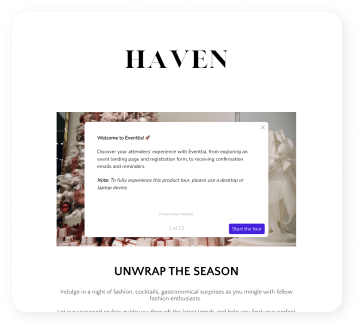Do you know the most common reason people don’t pay to attend your event? No, it’s not because your marketing campaign sucks. And it’s not because your event program or speakers aren’t interesting enough. Are you ready for the answer? If you don’t have a good pricing page, people tend to close the tab and forget all about your event.
“Why?” you must be thinking.
According to Kissmetrics, “People hit the Pricing page for one of two reasons. Either they’re getting a quick spot check; finding out if this option fits within their expected potential budget range. Or they’re deep in the weeds by this point, actively evaluating this option against a few others and deciding whether or not to click that button and give the free trial a spin.”
People in the second group are on their way to making a decision. If you take the time to set up a good pricing page, you are one click closer to new attendees who’ll be delighted to pay and attend your event.
“How is this possible?”
As Neil Patel explains in his article “9 Psychological Insights I Use When Designing a Pricing Page,” a good pricing page is based on customer psychology. Patel notes, “I constantly A/B-test my pages to make sure I’m choosing the most optimal design, and most of the design choices you see throughout my web properties is based on simple psychological principles.”
In other words, if you want to run a successful event for a decent number of attendees, you must design a good pricing page, providing appealing pricing plans that will convert people to attendees.
To do so, you must follow a series of rules that will improve the quality and attractiveness of your pricing page. Here are some of them:
Rule #1. Explain the benefits attendees will get by choosing a certain plan
A good pricing page will always pinpoint the “goodies” your attendees will receive when choosing a specific plan. However, be sure to set up the pricing plans by highlighting the relevant parts for each option.
For example, “simultaneous translation” shouldn’t be a benefit attendees can have access to only by upgrading to a more expensive plan. This is a basic need and should be covered automatically, regardless of the pricing plan. On the other hand, attending a cocktail dinner with the speakers is a special benefit in a more expensive pricing plan.
Rule #2. Show your attendees how they can save money and get more benefits
A good pricing page helps your guests to visualize the cost-benefit balance, so make sure to indicate just how much they’ll actually save by purchasing a more expensive plan.
Sound counterintuitive?
Let’s say you’re hosting a two-day conference. You set up a $100 plan for a one-day conference pass, but charge $150 for a two-day pass, which is $75 per day. Most likely, your intention is to sell a more expensive plan to as many people as possible. To enhance the higher plan’s attractiveness, emphasize on the pricing page that by purchasing the second option, attendees who want to attend both days will actually save 25%.
Rule #3. Reduce copy and keep it as simple as possible
Although a good pricing page is about correctly reflecting important information such as benefits, savings, and fees, remember to keep your copy to a minimum. As Peep Laja, the founder of CXL, argues, “When you start building your pricing page, the #1 question you have to ask yourself is, ‘how can we make this as easy as possible?’”
Don’t forget that most people (only the few truly interested ones) won’t spend too much time trying to “decipher” your pricing page, which could cost you potential attendees, so make sure your content is clear, clean, and simple.
Rule #4. Highlight one option
According to Kissmetrics, when setting up pricing plans for your event, it’s important to highlight one option. “If you ‘sneak’ your most profitable plan in the middle of your pricing page, visitors would most likely pick the middle option because that’s where they generally click, on average.” The only thing you must do is decide your profit maximizing plan and then make it as attractive as possible.
Rule #5. Don’t forget about the CTA language
According to Michael Aagaard, Unbounce’s senior conversion optimizer, commands such as Submit or Add to cart aren’t inspiring and may have a low conversion rate. That’s why, instead of using common and boring CTA language, don’t be afraid to try something a little different; for example, Add to cart: Save 25%.
As Aagaard argues, “the more value and relevance you can convey via your call-to-action copy, the more conversions you are likely to get,” meaning that a powerful CTA will increase the number of attendees.
Final thoughts
Believe it or not, your event’s success depends a great deal on having a good pricing page. However, only a few event managers and planners understand its true value. To attract new attendees and avoid the risk of canceling your event because of low attendance, be persistent in learning as much as possible about the conversion of pricing pages and plans. Afterward, experiment with different versions of your pricing page and see what works best. Don’t settle until you find the best option for you and your event.
Discover how Eventtia helps world-leading brands digitize and scale their events
Learn more
Share













